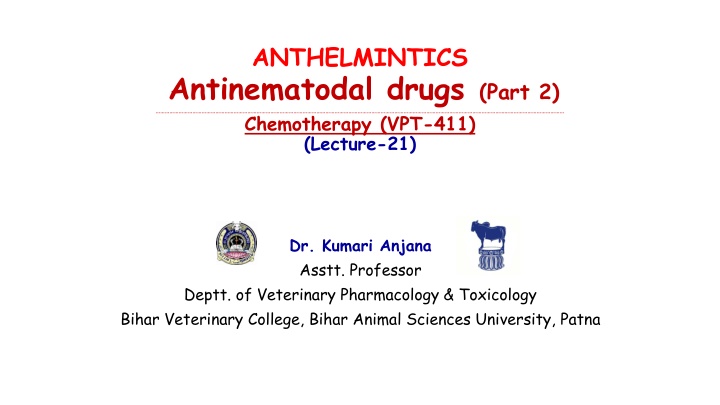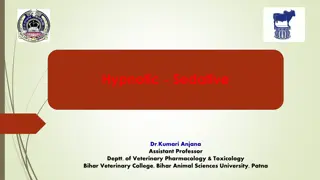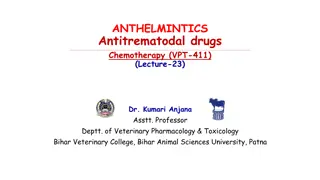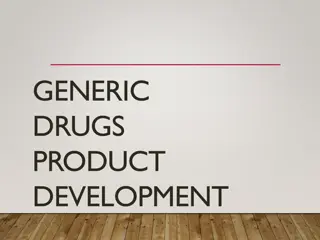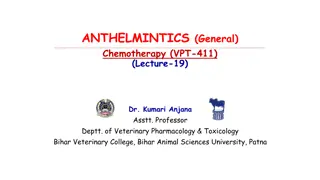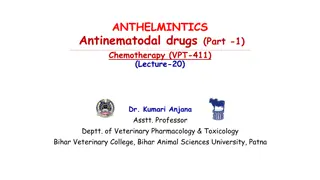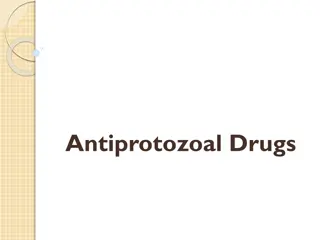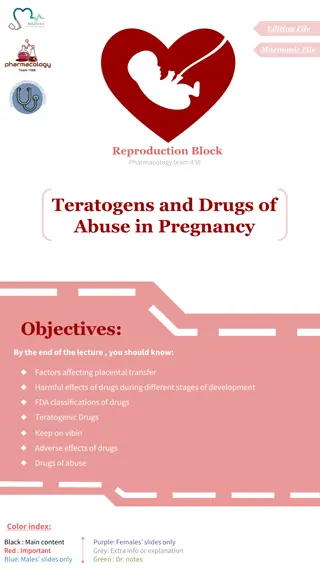Overview of Anthelmintic Drugs for Veterinary Use
This lecture delves into anthelmintic drugs used in veterinary medicine, focusing on Imidazothiazoles, Tetrahydrophyrimidines, OP Compounds, and Macrocyclic Lactones. Levamisole and Pyrantel are highlighted for their effectiveness against a range of parasites in various animal hosts, along with their mechanisms of action and host immune system modulation benefits. The content provides insights into the chemistry, spectrum, and impact of these drugs on parasites, making them crucial in the treatment and control of parasitic infections in animals.
Download Presentation

Please find below an Image/Link to download the presentation.
The content on the website is provided AS IS for your information and personal use only. It may not be sold, licensed, or shared on other websites without obtaining consent from the author.If you encounter any issues during the download, it is possible that the publisher has removed the file from their server.
You are allowed to download the files provided on this website for personal or commercial use, subject to the condition that they are used lawfully. All files are the property of their respective owners.
The content on the website is provided AS IS for your information and personal use only. It may not be sold, licensed, or shared on other websites without obtaining consent from the author.
E N D
Presentation Transcript
ANTHELMINTICS Antinematodal drugs (Part 2) Chemotherapy (VPT-411) (Lecture-21) Dr. Kumari Anjana Asstt. Professor Deptt. of Veterinary Pharmacology & Toxicology Bihar Veterinary College, Bihar Animal Sciences University, Patna
Content of the chapter Antinematodal drugs Imidazothiazoles Tetrahydrophyrimidines OP Compounds Macrocyclic lectones Drugs acting against Heartworms
Imidazothiazoles Butamisole Hydrochloride: It is an injectable anthelmintic used in dogs to treat whip worm (Trichuris vulpis) and hookworm (Ancylostoma caninum) infections. Tetramisole and Levamisole: Levamisole was developed following the introduction of tetramisole in 1966. Tetramisole is a racemic mixture of two isomers and the anthelmintic activity of mixture rested almost solely with the l-isomer, levamisole. This discovery made tetramisole an obsolete drug. By using levamisole the dose could be reduced to half, which provided both a more economic formulation and an increase in safety margin.
Chemistry: Levamisole is the levo-isomer of dl-tetramisole. It is used as hydrochloride salt, which is highly Soluble in water and therefore can be given orally or by injection. Spectrum: Levamisole is a commonly used antinematodal drug because of its broad range of activity in large number of hosts (sheep, cattle, pig, horse, chicken, dog and cat) Against almost all GI nematodes, lungworms and hookworms in ruminants, and immature stages of GI parasites of ruminants are effectively removed by levamisole. In poultry effective against Capillaria obstignata, Ascaridia galli and H. gallinarum. But is has no activity against flukes, tapeworms and protozoa.
The drug affects the neuromuscular system of the parasite by acting as cholinergic agonist. At high concentration in parasites, levamisole, like benzimidazoles interfere with carbohydrate metabolism by inhibiting fumerate reductase enzyme system. Host immune System: Levamisole modulates immunity of the host through stimulation of cell mediated immune reactivity. Enhancing the rate of T-lymphocyte differentiation and proliferation, responsiveness to antigens and mitogens lymphocytes. and activity of effector It is highly beneficial in immunologically depressed animals.
Tetrahydrophyrimidines Pyrantel: It is used as tartrate or palmoate salts. Broad-spectrum drug against Sheep cattle, swine, horse and dogs. MOA: A cholinergic agonist. sustained muscle contraction and paralysis of nematodes. The palmoate salt is poorly soluble in water, so less absorbed in the gut allowing the drug to reach pinworms and be effective against them in the lower end of large intestine. Pinworm infection of lower digestive tract in dogs.
Morantel: It is a methyl ester of pyrantel. Principallly morantel tartrate but also the fumerate salt is used as veterinary anthelmintic. The salts of morantel have greater anthelmintic activity than the pyrantel. The pharmacological properties are similar. Morantel tartrate is a safer drug than pyrantel tartrate. Administration and dosage: Morantel tartrate (Banminth II): Orally as aqueous solution: Dose: Sheep: mg/kg; Cattle: 8.8 mg/kg. A 4% ointment of the tartrate salt is used to treat Thelazia eye infections of cat.
OP Compounds The OP compounds were originally developed as systemic insecticides. Subsequently they are found to have also some anthelmintic property, but their safety is often poor. The compounds used in farm animals are- coumaphos, crufomate, haloxan and naptholphos, and In horse, dog and cat-dichiorvos and trichlorphon. MOA: Inhibition of acetylcholinesterase (Ache) enzyme.
Coumaphos (Asuntol): Originally developed as pesticide for treatment of external parasites of livestock and later used as an anthelmintic. The advantage of this drug is that it can be used in lactating animals without requiring the milk to be discarded after treatment used as a helminthes preventive.
Dichlorvos: It is effective against Toxocara,Toxascaris, Ancylostoma, Unciaria, Oesophagostomum spp., Ascaris suis, Trichuris Strongyles, Oxyuris equi, and Strongylus vulgaris. Valuable anthelmintic for dogs, cats, pigs and horses. suis, Parascaris equorum, small A chief advantage of dichlorvos over many broad-spectrum anthelmintics in dogs and swine is its efficacy against whipworms. It is not Effective against migrating hookworms and ascarid larvae and has on tapeworms.
Haloxon: It is effective against the GI nematodes of horse, sheep, cattle and pig. It is probably the safest OP anthelmintic in ruminants. Trichlorphon : It is a prodrug, metabolises rapidly to dichlorvos which is responsible for its therapeutic action. It is used as an insecticide (Neguvon) as well as anthelmintic in animals, principally in horses. It is used for the treatment of Bots in horses, GI nematodes in cattle, Haemonchus contortus and Oestrus ovis (nasal grab) sheep and Ascaris in pigs.
Naphtholphos: Abomasum and small intestine, but it is ineffective against the parasites of large intestine of ruminants. Oral administration provides anthelmintic activity in cattle and pour-on method of application control warble fly. Haemonchus, Cooperia, Bunostomum, and Trichostrongylus, Oesphagostomum, Capillaria and lungworms.
Macrocyclic lectones Avermectins Avermectins fermentation of actionmycete, Stryptomyces avermitilis. are a group of chemically related anthelmintics produced by the There are eight different components of avermectins namely A1a, A2a, B1a, B2a and A1b, A2b, B1b and B2b. Each of these components anthelmintic activity. The avermectins are also macrocyclic lactone derivatives, but in contrast to the macrolide or polyene antibiotics, they lack significant antibacterial or antifungal activity. The doramectin. avermectins in commercial use are ivermectin, abamectin and
Ivermectin Ivermectin dihydroavermectin B1a and 20% 22, 23 dihydroavermectin B1b. is a mixture comprising 80% 22, 23 It is a very potent nematocide and ectoparasiticide (endectocide) by oral and parenteral routes. Dung of ivermectin treated (ecological threat). animals does not decompose Cattle must not be treated within 21 days of slaughter. Ivermectin should not be used in milk producing animals or in dairy cows for 28 days prior to calving.
Milbemycin D: It is a natural product of Streptomyces hygroscopicus sp. Aureolacrimosus, and only used for treating dogs. It is active orally against dog roundworms and prophylactic against heartworms at higher monthly doses. Higher doses cause neurological Collie breeds of dogs.
Milbemycin oxime: It is used is used as tablets orally in dogs at monthly intervals for prevention of heart worm disease and to treat hookworms. Dose: 0.5mg/kg once monthly. Moxidectin: It is a semisynthetic derivative of milbemycin used for treating cattle. It is administered SC cattle and has same broad spectrum of activity against roundworms and ectoparasites as ivermectin. Dose: 0.2 mg/kg SC.
Drugs acting against Heartworms Elimination of adult heartworms: Thiacetarsamide sodium: Chemically it is an arsenical compound and is the only drug used for the elimination of adult heartworms in dogs. The drug does not affect the circulating microfilariae. Mode of action: The drug interferes with the energy production of the parasite by inhibition of glycolysis.
Following four therapeutic doses of thiacetarsamide, adult worms die usually within 5-7 day and occasionally not until 14 days. The dead worms are swept out of the heart by the flowing blood and lodge in the pulmonary artery, especially in the diaphragmatic lobes, where phagocytosis of dead worms occur during the next 2-3 months. To avoid embolism, absolute rest during the first two weeks is necessary.
The drug is hepatotoxic and nephrotoxic therefore proper functioning of liver and kidney must be attained before starting treatment. The drug is highly irritating to subcutaneous tissues. So, during IV injection care must be taken to avoid perivascular leakage as it may result in local swelling and sloughing. Injection of steroids into the area helps in reducing inflammation. Symptoms of arsenic toxicity like persistent vomiting, icterus or orange colored urine may be seen and the toxicity can be treated with dimcercaprol @ 8.8mg/kg/day in 4 divided doses.
Elimination of heartworm microfilariae: Elimination of heartworm microfilariae is essential as they cause glomerular damage in kidney. The preventive drug, diethylcarbamazine is not safe for use in dogs until they are cleared of microfilariae. Dithiazanine iodine: It is they only drug used as a heartworm microfilaricide in dogs. Dose: 6.6 mg/kg/day for 7-10 days as microfilariaecide. It should be given 6 months after the adulticidal drug.
The adulticidal drug is given at 6 months intervals @2.2 mg/kg IV twice for 2 days. Using larvaecidal drugs that kill the infective 3rdstage or developing 4th stage larvae (Diethylcarbamazine (DEC), ivermectin or milbemycin D etc). Monthly treatment with ivermectin as compared with the requirement of daily dosing with DEC gives the former drug the advantage as a potential preventive.
Diethylcarbamazine citrate: DEC is used as a heartworm preventive. The drug also act against microfilariae but unfortunately sometimes a fatal shock type of reaction occurs if the drug is given to microfilariae positive dogs. So an infected dog must be cleared of adult heartworms and microfilariae before starting it on DEC prophylaxis. In human it is used in filarial infection caused by W. bancrofti and tropical eosinophilia.
Miscellaneous Antinematodal Drugs n-Butyl chloride: It is a colorless liquid administered in gelatin capsules to dogs and cats after overnight fasting for control of ascarid and hookworm infections. Hookworms of dogs and cats. Bephenium hydroxynaphthoate: Most effective against mature hookworms of dogs and cats and human and also GI parasites of ruminants specially Nematodirus spp. and also Tichostrongylus, Bunostomum, Oesophagostomum and Cooperia species. Haemonchus, Ostertagia,
Disophenol (Ancylol): Chemically it is 2,6-diiodo-4-nitrophenol. It is an injectable antihookworm compound used in dogs and cats. Hygromycin B: This is an antibiotic obtained from Streptomyces hygroscopicus with anthelmintic activity. Hygromycin B is anthelmintic antibiotic Highly effective against A. sum and also Oesophagostomum of swine and A. galli, Capillaria obstignata and H.gallinarum in chickens. 8 weeks on and 8 weeks off.
Summary Thiacetarsamide sodium-Only drug used for the elimination of adult heartworms in dogs. The dead worms are swept out of the heart by the flowing blood and lodge in the pulmonary artery, especially in the diaphragmatic lobes. Dithiazanine iodine-- Elimination of heartworm microfilariae . Disophenol -injectable antihookworm compound . Hygromycin B is anthelmintic antibiotic.
